Norilsk, an urban polar laboratory in Russia

Inalco's CREE (Centre de recherche Europe Eurasie) has set among the priorities of its next five-year plan, a research axis devoted to the question of the heritage of post-Soviet states. Taline Ter Minassian, university professor and coordinator of this axis, is a specialist in the history of the USSR, Russia and the Caucasus.
The Russian city of Norilsk is located in an extreme environment on the edge of Siberia, north of the Krasnoyarsk Territory, at the gateway to the Taimyr Peninsula. With almost 200,000 inhabitants, Russia's most northerly city is, after Murmansk, the second most populous beyond the Arctic Circle. Built on permafrost, Norilsk is a place of exceptional urban, architectural and social experimentation. Its existence is historically linked to the "Noril'lag" concentration camp system and the exploitation of the tundra's natural resources, in particular nickel, a mineral essential to the economy of the Soviet military-industrial complex. In 2018, the city will celebrate its 65th anniversary. It is seeking to erase the memory of its concentration camp past and enhance its heritage.
Even today, the city remains closed to foreigners and is only accessible with special authorization from the Russian security services. Following in the footsteps of the polar city's Armenian architects, the multidisciplinary team embarked on an exploratory mission that addressed a number of issues: the creation of identities in a polar urban context; the architectural prospecting of urban strata; the formation of local patriotism in the context of a pioneering front; and a comparative social study with other mining systems, such as that of New Caledonia. The scientific challenge is to complete our knowledge of the history of urban planning.
Located north of the Poutorana Plateau nature reserve, Norilsk is at the heart of the "reindeer civilization" region, in a complete set of Arctic and sub-Arctic ecosystems. It is reputed to be one of the most polluted cities in the world.
Scientific contacts:
Taline Ter Minassian, university professor at Inalco, Laboratoire CREE
Sophie Hohmann, teacher-researcher at Inalco, Laboratoire CREE
Associated work:
Norilsk, architecture in the gulag: a Caucasian history of the Soviet polar city
Collection Patrimoine, B2 Editions, May 2018
ISBN 978-2-36509-087-2